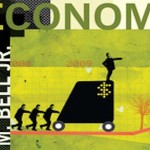Editor’s Note: As regular blog readers will have seen yesterday, a big topic at the recent Fare Forward symposium was the the Christian vocation to be faithfully present in institutions. Coincidentally, noted Christian public intellectual Andy Crouch published at the same time a piece on institutional life in Christianity today. Based on whether you like to talk about institutions or not, this timing was either something providential or a bit more sinister. Either way, we thought it provided a good jumping off place to continue the conversation. Here are two reflections on Crouch’s piece by regular FF writers.
Cole Carnesecca:
In a recent Christianity Today article, Andy Crouch gives a brief introduction to the possible benefits of a proper view of institutions. Crouch’s take on institutions brings out a number of the more important aspects of how institutions influence cultural transmission, the dangers centralization of cultural control can pose, and the possible benefits of healthy and reflexive institutional life. It certainly is true that institutions are important, but I couldn’t help but be concerned about the underdeveloped discussion of the relationships of movements to institutions and the broader questions of which institutions we should ultimately be concerned about.
The first question is predominantly a historical one. Crouch notes that it is important that movements make the transition to institutions – securing the proper transmission of the value of the movement to later generations. However, this misses two critical issues related to movements. The first is that many movements are not meant to be institutionalized. Often, movements are attempts by a broad-based group to enact specific changes in an existing institutional structure. In such cases, there’s no reason to institutionalize a movement. The goals of the movement, rather, need to be institutionalized in the already existing institutions. Various reform movements in the church’s history (such as monastic movements, or widespread revivals like the Great Awakening) are significant examples of this relationship. In fact, the institutionalization of a movement often represents some failure on the part of entrenched institutions to properly respond to the pressing concerns of movements. If a movement must perpetuate itself then it has failed as reform and become something else – a gap filler. The imposition of a desire to institutionalize on a movement can be there very thing that kills its effectiveness. Most movements are meant to be disposable and we need to be ok with that.
But which institutions are we primarily concerned with? Which ones are our movements aimed at reforming? Based on Crouch’s article, this would seem to be limited to the Christian sphere. Our churches, our organizations, our communities of practice and belief. That point is, to an extent, a given. It goes without saying that we should be concerned with the transmission of practices and values within our own institutions. However, Christian institutions provide a stark minority of practice and values that shape our daily lives. Our lives are dominated by structures of education, career, state, and the myriad other public social structures in which we are embedded. These institutions, however, are ones over which we have more or less lost influence. To be sure, American Christianity’s production of counter institutions has produced sizable systems of education, publication, information and communication. However, as James Davison Hunter convincingly argues, this has gained us little in the way of broader influence or impact. The history of the last few hundred years has been one of a progressive retreat from public institutional life – particularly those institutions that speak into our daily cultural lives.
The upshot of this is not the rejection of Crouch’s basic argument. Institutions are important. Crucially important. But that doesn’t simply require us to think more about the role of institutions in our collective lives. It means we need to think deeper, think smarter, about what institutional life requires of us – what it can give and what it can take away.
Cole Carnesecca is a Ph.D. candidate in Sociology at the University of Notre Dame and teaches at Bethel College in Indiana.
Jake Meador:
A few months ago my pastor was preaching through Acts 6, the text when the early church appointed deacons to oversee food distribution to widows in the church. One of the main points Ben made as he spoke about the text is that in this case the structure and organization of an institution was actually used to accomplish a good that could not have been accomplished in an easier, more effective way. The organization and structure inherent in an institution, in other words, could be effectively used to serve the common good.
I thought of Ben’s sermon as I read Andy Crouch’s latest Christianity Today editorial “Planting Deep Roots”:
For cultural change to grow and persist, it has to be institutionalized, meaning it must become part of the fabric of human life through a set of learnable and repeatable patterns. It must be transmitted beyond its founding generation to generations yet unborn. There is a reason that the people of God in the Hebrew Bible are so often named as the children of “Abraham, Isaac, and Jacob.” Like divine intervention in history, true cultural change takes generations to be fully absorbed and expressed.
Indeed, the best institutions extend shalom—that rich Hebrew word I paraphrase as “comprehensive flourishing”—through both space and time. Take one of my favorite institutions: the game of baseball. It is a set of cultural patterns that has lasted for several generations now, played at a professional level on several continents. A great game of baseball is mentally, physically, and emotionally taxing and fulfilling in the way that all deeply human endeavors are. It embodies the playfulness and competitiveness that reflects our God-given creativity and ambition for excellence. It is an institution, larger than any individual player.
At their best, institutions make room for diversity. One difference between a baseball game and a simple game of catch in the backyard is the range of positions available in the fully “institutionalized” form. Catcher and pitcher, right field and left field, first base and third base—for all their similarities, each of these positions rewards a slightly different set of abilities. The result is the abundance and variety God intends for the world.
Last weekend at the Fare Forward symposium, Adam Myers gave a talk on the necessity of thinking institutionally and the need to “re-enchant” our institutions. The goal of this move isn’t some sort of token gesture toward bureaucracy or traditionalism, but to enable our church communities and their attendant institutions (universities, hospitals, social services, businesses, and so on) to promote the common good to the best of their ability.
After all, while it may be true that a stagnating institution can act viciously and do real harm, it’s equally true that a complete lack of any institutional form can do an invisible sort of harm by destroying the potential for great good to be accomplished. The lack of institutional structure can limit the scope of an idea or of a group’s work, making it next to impossible to replicate in other places. Likewise, the lack of institutional structure can make seemingly logistical difficulties suddenly seem insurmountable. But most basic of all, the lack of an institution can destroy institutional memory, thereby eroding a community’s ability to remember its stories and even remember itself—things which can only lead to the individualistic disintegration of community so common in the contemporary west.
To perhaps put a bit of flesh on the above paragraph, try imagining Merry and Pippin without the de facto institutions of The Shire, without the defined pace of life, the observance of certain feasts, holidays, and basic customs, and without the connectedness they had with their neighbors, friends, and family. Perhaps more to the point, try imagining how J.R.R. Tolkien might have created such delightful characters apart from the institution of Oxford.
Jake Meador is a 2010 graduate of the University of Nebraska-Lincoln where he majored in English and History. He currently works as a blogger and social media consultant with Rent Ping Media here in Lincoln, Nebraska.
[Image of a Hobbit Hole from Wikipedia]











